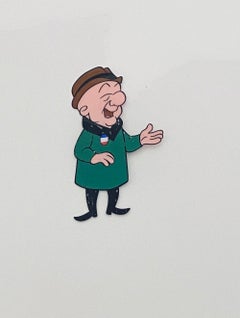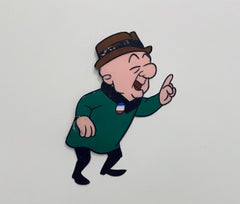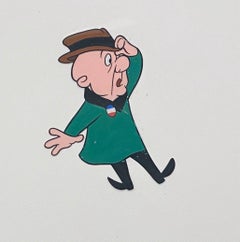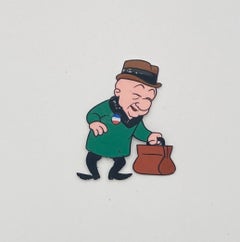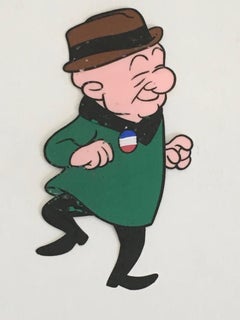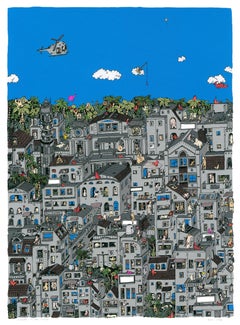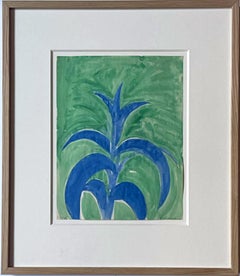Jules Engel Mixed Media
to
7
Overall Width
to
Overall Height
to
7
6
1
5
2
7
17
296
263
150
147
7
Artist: Jules Engel
Mr. Magoo Original Vintage Animation Cel Hand Drawing Painting
By Jules Engel
Located in Surfside, FL
Born in 1918 in Budapest, Hungary, Engel began his professional career in animation as a color designer at the Walt Disney studio. Although his credits include work on such classics as Disney’s Bambi and Fantasia and UPA’s Gerald McBoing-Boing, he is best known as a mentor to literally hundreds of students.
Engel was also one of the original members of United Productions of America (UPA), where, during the ’50s, he worked on classics such as Mr. Magoo, Gerald McBoing-Boing and Madeline. According to his biographer, Dr. Janeann Dill, Engel has created more than 33 personal films and received five Golden Eagle awards, an Annie Award, a Winsor McCay Award, the Fritz Award, a Jean Vigo Award, and the Norman McLaren...
Category
Mid-20th Century Pop Art Jules Engel Mixed Media
Materials
Mixed Media
Mr. Magoo Original Vintage Animation Cel Hand Drawing Painting
By Jules Engel
Located in Surfside, FL
Born in 1918 in Budapest, Hungary, Engel began his professional career in animation as a color designer at the Walt Disney studio. Although his credits include work on such classics as Disney’s Bambi and Fantasia and UPA’s Gerald McBoing-Boing, he is best known as a mentor to literally hundreds of students.
Engel was also one of the original members of United Productions of America (UPA), where, during the ’50s, he worked on classics such as Mr. Magoo, Gerald McBoing-Boing and Madeline. According to his biographer, Dr. Janeann Dill, Engel has created more than 33 personal films and received five Golden Eagle awards, an Annie Award, a Winsor McCay Award, the Fritz Award, a Jean Vigo Award, and the Norman McLaren...
Category
Mid-20th Century Pop Art Jules Engel Mixed Media
Materials
Mixed Media
Mr. Magoo Original Vintage Animation Cel Hand Drawing Painting
By Jules Engel
Located in Surfside, FL
Born in 1918 in Budapest, Hungary, Engel began his professional career in animation as a color designer at the Walt Disney studio. Although his credits include work on such classics as Disney’s Bambi and Fantasia and UPA’s Gerald McBoing-Boing, he is best known as a mentor to literally hundreds of students.
Engel was also one of the original members of United Productions of America (UPA), where, during the ’50s, he worked on classics such as Mr. Magoo, Gerald McBoing-Boing and Madeline. According to his biographer, Dr. Janeann Dill, Engel has created more than 33 personal films and received five Golden Eagle awards, an Annie Award, a Winsor McCay Award, the Fritz Award, a Jean Vigo Award, and the Norman McLaren...
Category
Mid-20th Century Pop Art Jules Engel Mixed Media
Materials
Mixed Media
Mr. Magoo Original Vintage Animation Cel Hand Drawing Painting
By Jules Engel
Located in Surfside, FL
Born in 1918 in Budapest, Hungary, Engel began his professional career in animation as a color designer at the Walt Disney studio. Although his credits include work on such classics as Disney’s Bambi and Fantasia and UPA’s Gerald McBoing-Boing, he is best known as a mentor to literally hundreds of students.
Engel was also one of the original members of United Productions of America (UPA), where, during the ’50s, he worked on classics such as Mr. Magoo, Gerald McBoing-Boing and Madeline. According to his biographer, Dr. Janeann Dill, Engel has created more than 33 personal films and received five Golden Eagle awards, an Annie Award, a Winsor McCay Award, the Fritz Award, a Jean Vigo Award, and the Norman McLaren...
Category
Mid-20th Century Pop Art Jules Engel Mixed Media
Materials
Mixed Media
Mr. Magoo Original Vintage Animation Cel Hand Drawing Painting
By Jules Engel
Located in Surfside, FL
Born in 1918 in Budapest, Hungary, Engel began his professional career in animation as a color designer at the Walt Disney studio. Although his credits include work on such classics ...
Category
Mid-20th Century American Modern Jules Engel Mixed Media
Materials
Mixed Media
Mr. Magoo Original Vintage Animation Cel Hand Drawing Painting
By Jules Engel
Located in Surfside, FL
Born in 1918 in Budapest, Hungary, Engel began his professional career in animation as a color designer at the Walt Disney studio. Although his credits include work on such classics as Disney’s Bambi and Fantasia and UPA’s Gerald McBoing-Boing, he is best known as a mentor to literally hundreds of students.
Engel was also one of the original members of United Productions of America (UPA), where, during the ’50s, he worked on classics such as Mr. Magoo, Gerald McBoing-Boing and Madeline. According to his biographer, Dr. Janeann Dill, Engel has created more than 33 personal films and received five Golden Eagle awards, an Annie Award, a Winsor McCay Award, the Fritz Award, a Jean Vigo Award, and the Norman McLaren...
Category
Mid-20th Century Pop Art Jules Engel Mixed Media
Materials
Mixed Media
Mr. Magoo Original Vintage Animation Cel Hand Drawing Painting
By Jules Engel
Located in Surfside, FL
Born in 1918 in Budapest, Hungary, Engel began his professional career in animation as a color designer at the Walt Disney studio. Although his credits include work on such classics ...
Category
Mid-20th Century Pop Art Jules Engel Mixed Media
Materials
Mixed Media
Related Items
Fishing in the Clouds, fantastical jungle inspired cityscape by Guillaume Cornet
By Guillaume Cornet
Located in Dallas, TX
GUILLAUME CORNET (b. 1987, Paris, France)
Guillaume Cornet is an artist working with illustration and painting, exploring notions of abstract geometry, influenced by surreal perspec...
Category
2010s Pop Art Jules Engel Mixed Media
Materials
Watercolor, Permanent Marker, Screen, Mixed Media
$640 Sale Price
20% Off
H 21 in W 14 in D 2 in
Untitled (homage to Ellsworth Kelly) 1950s watercolor signed by Robert Indiana
By Robert Indiana
Located in New York, NY
Robert Indiana
Untitled homage to Ellsworth Kelly (Acquired from the studio of Robert Indiana), 1959
Watercolor and pencil on Plover Bond paper
This is an original, hand signed and d...
Category
1950s Pop Art Jules Engel Mixed Media
Materials
Watercolor, Graphite
"Montage (Gaming)" Charles Green Shaw, Playing Cards Collage, Games
By Charles Green Shaw
Located in New York, NY
Charles Green Shaw
Montage (Gaming), circa 1935
18th Century print, playing cards
15 x 10 inches
Charles Green Shaw, born into a wealthy New York family, began painting when he was...
Category
1930s American Modern Jules Engel Mixed Media
Materials
Mixed Media
Ann Miller in Follies Broadway Musical Contemporary Drawing Illustration Eloise
Located in New York, NY
Ann Miller in Follies Broadway Musical Contemporary Drawing Illustration Eloise
Ann Miller in Stephen Sondheim's "Follies." The 1998 production, played at the Papermill Playhouse. Affixed to the back of the drawing is a brochure promoting the show. Mixed media on paper. Signed lower left. Inscribed lower right: "Ann Miller at 75 'I'm Still Here' in Stephen Sondheim's 'Follies' 1998." Framed. 17 x 12 in. (sight). 22 1/2 x 17 1/2 in. (frame)
'Tops in Taps' Ann Miller was still going strong at 75 years old when she made her last appearance in the musical, "Follies." She was one of M.G.M's most prolific dancers and considered by many to be the greatest female tap dancer of all time.
Hilary, a friend of many years, is still going strong at 96. We saw this production at the Papermill Playhouse. Years ago, I was a press agent working in Henry Luhrman's office where we represented "Sugar Babies" with Ann Miller and Mickey Rooney.
Bio
Hilary Knight (born November 1, 1926) is an American writer-artist who is the illustrator of more than 50 books and the author of nine books. He is best known as the illustrator of Kay Thompson's Eloise (1955) and others in the Eloise series.
Knight has illustrated for a wide variety of clients, creating artwork for magazines, children's fashion advertisements, greeting cards, record albums and posters for Broadway musicals, including Gypsy, Irene, Half A Sixpence, Hallelujah Baby! and No, No Nanette.
The son of artist-writers Clayton Knight...
Category
1990s Performance Jules Engel Mixed Media
Materials
Paper, Mixed Media
Original Figurative Portrait Painting by Cuban Artist Juan Carlos Vazquez Lima
Located in Brooklyn, NY
ARTIST— Juan Carlos Vazquez Lima
Juan Carlos was born in Havana Cuba June 30th 1986. He Studied at Eduardo Garcia Delgado School of Art. He currently lives and works in Havana.
PAI...
Category
2010s Pop Art Jules Engel Mixed Media
Materials
Acrylic, Ballpoint Pen
$1,120 Sale Price
20% Off
H 16 in W 10 in
Original handwritten Letter of thanks, hand signed by Keith Haring on letterhead
By Keith Haring
Located in New York, NY
Keith Haring
Original Handwritten, hand signed Letter, ca. 1987
Ink on Haring's Private letterhead Stationery, Hand written and hand signed by Keith...
Category
1980s Pop Art Jules Engel Mixed Media
Materials
Paper, Ink, Permanent Marker
Untitled (de Kooning) Collage, offset lithograph hand-cutting, hand-paint Signed
By Richard Prince
Located in New York, NY
Richard Prince
Untitled (de Kooning), 2008
Collage with color offset lithograph, hand-cutting, hand-painting and assemblage with extensive additions in graphite mounted on on inset b...
Category
Early 2000s Pop Art Jules Engel Mixed Media
Materials
Paper, Mixed Media, Color Pencil, Graphite, Offset
Richard PrinceUntitled (de Kooning) Collage, offset lithograph hand-cutting, hand-paint Signed, 2008
$8,800
H 14.5 in W 14.5 in D 1.5 in
Guardian Ver. II (framed original drawing on paper)
By Peter Max
Located in Aventura, FL
Original crayon and pencil drawing on paper. Hand signed and dated on front by Peter Max. Remarqued and hand signed on frame verso by Peter Max. Paper size: 6 x 7.8 inches. Frame...
Category
21st Century and Contemporary Pop Art Jules Engel Mixed Media
Materials
Paper, Mixed Media, Crayon, Pencil
$2,062 Sale Price
25% Off
H 18.25 in W 20 in D 1 in
Original flower drawing on Rockefeller Center Puppy print, Hand Signed by Koons
By Jeff Koons
Located in New York, NY
Jeff Koons
Original flower drawing on Rockefeller Center Puppy poster (Hand Signed), 2000
Drawing done in silver marker on offset lithograph
Hand signed by Jeff Koons in marker on t...
Category
Early 2000s Pop Art Jules Engel Mixed Media
Materials
Permanent Marker, Lithograph, Offset
Abstraction (Untitled)
Located in Los Angeles, CA
Abstraction (Untitled), c. 1930s, mixed media on board, signed lower right, 8 ¼ x 7 inches (image), 15 x 10 inches (board), Literature: Achieving Recognition, American Fine Art Magaz...
Category
1930s American Modern Jules Engel Mixed Media
Materials
Mixed Media, Board
Original Figurative Portrait Painting by Cuban Artist Juan Carlos Vazquez Lima
Located in Brooklyn, NY
ARTIST— Juan Carlos Vazquez Lima
Juan Carlos was born in Havana Cuba June 30th 1986. He Studied at Eduardo Garcia Delgado School of Art. He currently lives and works in Havana.
PAI...
Category
2010s Pop Art Jules Engel Mixed Media
Materials
Acrylic, Ballpoint Pen
$2,080 Sale Price
20% Off
H 30 in W 22 in
Murakami Original hand signed Flower Drawing on limited edition skateboard deck
By Takashi Murakami
Located in New York, NY
Takashi Murakami
Original hand signed Flower Drawing on limited edition skateboard, 2017
Unique Flower Drawing in Marker on skateboard. Signed by Murakami
Flower drawing done in mark...
Category
2010s Pop Art Jules Engel Mixed Media
Materials
Wood, Mixed Media, Permanent Marker, Screen
$4,500
H 31 in W 8 in D 0.25 in
Previously Available Items
Mr. Magoo Original Vintage Animation Cel Hand Drawing Painting
By Jules Engel
Located in Surfside, FL
Born in 1918 in Budapest, Hungary, Engel began his professional career in animation as a color designer at the Walt Disney studio. Although his credits include work on such classics as Disney’s Bambi...
Category
Mid-20th Century American Modern Jules Engel Mixed Media
Materials
Mixed Media
Mr. Magoo Original Vintage Animation Cel Hand Drawing Painting
By Jules Engel
Located in Surfside, FL
Born in 1918 in Budapest, Hungary, Engel began his professional career in animation as a color designer at the Walt Disney studio. Although his credits include work on such classics as Disney’s Bambi...
Category
Mid-20th Century Pop Art Jules Engel Mixed Media
Materials
Mixed Media
Mr. Magoo Original Vintage Animation Cel Hand Drawing Painting
By Jules Engel
Located in Surfside, FL
Born in 1918 in Budapest, Hungary, Engel began his professional career in animation as a color designer at the Walt Disney studio. Although his credits include work on such classics as Disney’s Bambi...
Category
Mid-20th Century Pop Art Jules Engel Mixed Media
Materials
Mixed Media
Mr. Magoo Original Vintage Animation Cel Hand Drawing Painting
By Jules Engel
Located in Surfside, FL
Born in 1918 in Budapest, Hungary, Engel began his professional career in animation as a color designer at the Walt Disney studio. Although his credits include work on such classics ...
Category
Mid-20th Century Pop Art Jules Engel Mixed Media
Materials
Mixed Media
Mr. Magoo Original Vintage Animation Cel Hand Drawing Painting
By Jules Engel
Located in Surfside, FL
Born in 1918 in Budapest, Hungary, Engel began his professional career in animation as a color designer at the Walt Disney studio. Although his credits include work on such classics as Disney’s Bambi...
Category
Mid-20th Century Pop Art Jules Engel Mixed Media
Materials
Mixed Media
Mr. Magoo Original Vintage Animation Cel Hand Drawing Painting
By Jules Engel
Located in Surfside, FL
Born in 1918 in Budapest, Hungary, Engel began his professional career in animation as a color designer at the Walt Disney studio. Although his credits include work on such classics as Disney’s Bambi...
Category
Mid-20th Century Pop Art Jules Engel Mixed Media
Materials
Mixed Media
Mr. Magoo Original Vintage Animation Cel Hand Drawing Painting
By Jules Engel
Located in Surfside, FL
Born in 1918 in Budapest, Hungary, Engel began his professional career in animation as a color designer at the Walt Disney studio. Although his credits include work on such classics as Disney’s Bambi and Fantasia and UPA’s Gerald McBoing-Boing, he is best known as a mentor to literally hundreds of students.
Engel was also one of the original members of United Productions of America (UPA), where, during the ’50s, he worked on classics such as Mr. Magoo, Gerald McBoing-Boing and Madeline. According to his biographer, Dr. Janeann Dill, Engel has created more than 33 personal films and received five Golden Eagle awards, an Annie Award, a Winsor McCay Award, the Fritz Award, a Jean Vigo Award, and the Norman McLaren Heritage Award.
In 1960, Engel received an Oscar nomination for Icarus Montgolfier Wright, a film scripted by Ray Bradbury and directed and produced by Engel and his partners at Format Films, the late Herb Klynn and Buddy Getzler. Coaraze, a film Engel made in France in 1965, garnered the Jean Vigo Award, the French equivalent of an Oscar.
As the founding director of the CalArts Experimental Animation Program, Engel has taught several generations of students about the importance of his favorite art form. His former students include Henry Selick, Eric Darnell, Kathy Rose...
Category
Mid-20th Century Pop Art Jules Engel Mixed Media
Materials
Mixed Media
Mr. Magoo Original Vintage Animation Cel Hand Drawing Painting
By Jules Engel
Located in Surfside, FL
Born in 1918 in Budapest, Hungary, Engel began his professional career in animation as a color designer at the Walt Disney studio. Although his credits include work on such classics as Disney’s Bambi...
Category
Mid-20th Century Pop Art Jules Engel Mixed Media
Materials
Mixed Media
Mr. Magoo Original Vintage Animation Cel Hand Drawing Painting
By Jules Engel
Located in Surfside, FL
Born in 1918 in Budapest, Hungary, Engel began his professional career in animation as a color designer at the Walt Disney studio. Although his credits include work on such classics ...
Category
Mid-20th Century Pop Art Jules Engel Mixed Media
Materials
Mixed Media
Mr. Magoo Original Vintage Animation Cel Hand Drawing Painting
By Jules Engel
Located in Surfside, FL
Born in 1918 in Budapest, Hungary, Engel began his professional career in animation as a color designer at the Walt Disney studio. Although his credits include work on such classics ...
Category
Mid-20th Century American Modern Jules Engel Mixed Media
Materials
Mixed Media
Jules Engel mixed media for sale on 1stDibs.
Find a wide variety of authentic Jules Engel mixed media available for sale on 1stDibs. You can also browse by medium to find art by Jules Engel in mixed media and more. Much of the original work by this artist or collective was created during the 20th century and is mostly associated with the Pop Art style. Not every interior allows for large Jules Engel mixed media, so small editions measuring 11 inches across are available. Customers who are interested in this artist might also find the work of Ann Chernow, Raymond Pettibon, and Hilary Bond. Jules Engel mixed media prices can differ depending upon medium, time period and other attributes. On 1stDibs, the price for these items starts at $650 and tops out at $650, while the average work can sell for $650.
